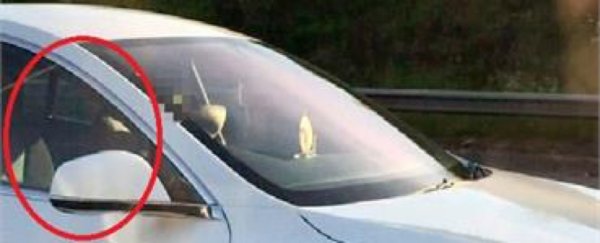Sometimes you really just need to sit back, relax, and watch the world go by.
Those times should never be when you're the only person travelling in an automobile cruising down the freeway in heavy traffic, along what is one of the UK's biggest and busiest roads.
But that's exactly what 39-year-old Nottingham resident Bhavesh Patel did one Sunday evening last May, curiously deciding to vacate the driver's seat of his Tesla Model S to enjoy the even roomier comfort of the passenger seat instead.
This mid-journey manoeuvre took place as Patel travelled down the M1, one of England's oldest and most famous motorways, which extends some 311 kilometres (193 miles) between London and Leeds.

As you will have no doubt figured out, this seat-switching trick isn't something you could easily pull off in any ordinary car – at least not for very long without crashing into something or dangerously veering off the side of the road.
Luckily (or unluckily) for Patel, his Model S features Tesla's much-hyped but controversial Autopilot feature, meaning the vehicle can effectively drive itself in freeway conditions, thanks to a bevy of advanced sensors, algorithms, and monitoring equipment.
Note that we said effectively: not legally. Pretty much everywhere, vehicles that are cleared to use assistive driving systems like this on public roads are only supposed to aid drivers, who are legally required to stay in their seat, keep their hands on the steering wheel, and remain alert to control the car at all times.
Clearly, Patel wasn't doing any of this, and he might have gotten away with his Sunday evening hijinks if it weren't for a witness to his antics filming him on their phone from another car.
The footage shows Patel – who pled guilty to dangerous driving at St Albans Crown Court on Friday April 20 – sitting alone in the car in the passenger seat, with his hands behind his head, while the driver's seat is oddly vacant.
Estimates put the Tesla's speed at about 40 miles per hour (64 kilometres per hour) at the time of the incident, as the vehicle travelled north near the town of Hemel Hempstead, northwest of London.
When interviewed later by police, Patel admitted he knew what he had done was "silly", but boasted the Tesla was capable of something "amazing", claiming he was just the "unlucky one who got caught".
Understandably, the authorities had a somewhat different view of his actions.
"What Patel did was grossly irresponsible and could have easily ended in tragedy," says investigating officer PC Kirk Caldicutt from Hertfordshire Police.
"He not only endangered his own life but the lives of other innocent people using the motorway on that day."
It's not the first time we've seen people caught out for abusing Autopilot and the leeway it gives them.
Of course, in the future, fully self-driving and autonomous cars are expected to not have these the kinds of legal and operational limitations, meaning we won't have to stay alert to control vehicles.
And depending on their designs – which could include cars without steering wheels, gear sticks, and pedals – we might not be able to take control, even if we wanted to.
But until those very much still-in-development systems see the light of day, the authorities are hoping to send a strong message to the community, to dissuade others from treating the technology we have now like their own personal chauffeur.
For his actions, Patel was disqualified from driving for 18 months, sentenced to do 100 hours of unpaid work, and ordered to carry out 10 days of rehabilitation, in addition to having to pay costs of £1,800 (almost US$2,500).
"This case should serve as an example to all drivers who have access to autopilot controls and have thought about attempting something similar," Caldicutt says.
"I want to stress that they are in no way a substitute for a competent motorist in the driving seat who can react appropriately to the road ahead."
